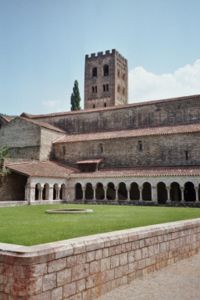
Saint-Michel-de-Cuxa
Encyclopedia

Benedictine
Benedictine refers to the spirituality and consecrated life in accordance with the Rule of St Benedict, written by Benedict of Nursia in the sixth century for the cenobitic communities he founded in central Italy. The most notable of these is Monte Cassino, the first monastery founded by Benedict...
abbey
Abbey
An abbey is a Catholic monastery or convent, under the authority of an Abbot or an Abbess, who serves as the spiritual father or mother of the community.The term can also refer to an establishment which has long ceased to function as an abbey,...
located in the territory of the commune of Codalet
Codalet
Codalet is a commune in the Pyrénées-Orientales department in southern France.It is very small with only a few streets but has a lot of character. There are no shops but there is a little park with a boules court and soccer goal as well as a river running through it. Codalet has an annual garage...
, in the Pyrénées-Orientales
Pyrénées-Orientales
Pyrénées-Orientales is a department of southern France adjacent to the northern Spanish frontier and the Mediterranean Sea. It also surrounds the tiny Spanish enclave of Llívia, and thus has two distinct borders with Spain.- History :...
département, in southwestern France
France
The French Republic , The French Republic , The French Republic , (commonly known as France , is a unitary semi-presidential republic in Western Europe with several overseas territories and islands located on other continents and in the Indian, Pacific, and Atlantic oceans. Metropolitan France...
. It was an important cultural centre in the regency of Abbot Oliva
Abbot Oliva
Oliva was the count of Berga and Ripoll and later bishop of Vic and abbot of Sant Miquel de Cuixà. He was the son of a noble Catalan house who abdicated his secular possessions to take up the Benedictine habit in the Monastery of Santa Maria de Ripoll...
.
Foundation and apogee of the abbey
The origins of Cuixà abbey lie at Sant Andreu d'Eixalada abbey, founded in about 840, and located at the head of the TetTêt River
The Têt is the largest river in Roussillon, southeastern France. It is 116 km long. The Têt has its source at the foot of the Pic Carlit in the Pyrenees...
valley. In the autumn of 878, the river broke its banks, flooding and destroying the monastery (located near the river-bed) forcing the monks to seek refuge in the surrounding countryside. The community then transferred to Cuixà, a minor cenobitic community dedicated to Saint Germanus
Saint Germanus
Saint Germanus may refer to:*Germanus , Spanish martyr-saint *Germanus of Auxerre , bishop of Auxerre who founded the Carolingian abbey of Saint-Germain en Auxerre named for the same saint...
, led by Father Protasius.
In June 879, Protasius and Miro the Elder
Miro the Elder
Miro, called the Old or the Elder was the count of Conflent from 870 and Rosselló from 878 until his death...
, count of Conflent
County of Conflent
The County of Conflent or Confluent was one of the Catalan counties of the Marca Hispanica in the ninth century. Usually associated with the County of Cerdanya and the county of Razès, and was located to the west of Roussillon...
and Roussillon
Counts of Roussillon
This is a list of the counts of Roussillon, in Catalan Rosselló.-Carolingian counts:These counts were nominated by the Carolingian kings of France, of whom they were vassals.*Gaucelm Hereafter, also counts of Barcelona....
, signed the founding treaty of the new monastery, whereby Cuixà extended its properties with those contributed by Eixalada and Protasius was named abbot.
The abbey continued under the protection of the count of Cerdanya and Conflent. The territory then came under the domain of the family of Wilfred I
Wilfred the Hairy
Wilfred or Wifred, called the Hairy, was Count of Urgell , Cerdanya , Barcelona , Girona , Besalú , and Ausona ....
, count of Barcelona in 870. In about 940, under the initiative of Sunifred II of Cerdanya, a new church dedicated to Saint Michael was built. In 956 the building was refurbished and made more sumptuous; the main altar was consecrated on 30 September 974 by Garí, a monk from Cluny
Cluny Abbey
Cluny Abbey is a Benedictine monastery in Cluny, Saône-et-Loire, France. It was built in the Romanesque style, with three churches built in succession from the 10th to the early 12th centuries....
who led five southern monasteries.
When the Doge of Venice
Doge of Venice
The Doge of Venice , often mistranslated Duke was the chief magistrate and leader of the Most Serene Republic of Venice for over a thousand years. Doges of Venice were elected for life by the city-state's aristocracy. Commonly the person selected as Doge was the shrewdest elder in the city...
, Pietro I Orseolo
Pietro I Orseolo
Pietro I Orseolo was the Doge of Venice from 976 to 978. He is venerated as a saint by the Roman Catholic Church. He was born near Udine to one of the more powerful families in Venice...
, accepted Romuald
Romuald
Saint Romuald was the founder of the Camaldolese order and a major figure in the eleventh-century "Renaissance of eremitical asceticism"....
's advice to become a monk, abdicated his office, and fled in the night, it was to Saint-Michel-de-Cuxa that he retired, accompanied by Romuald and his companion, Marinus, who established a hermitage nearby.
See also
- The CloistersThe CloistersThe Cloisters is a museum located in Fort Tryon Park, New York City. The building, which is a branch of the Metropolitan Museum of Art, was reconstructed in the 1930s from the architectural elements of several European medieval abbeys...

